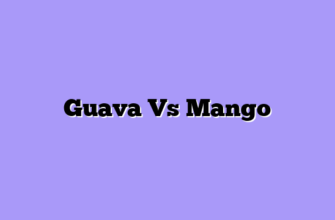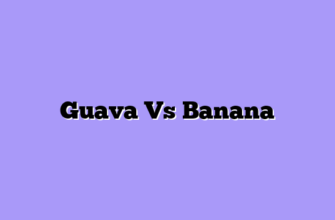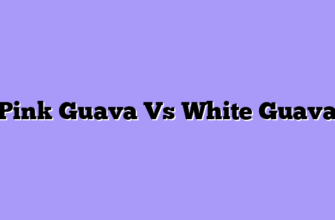Guavas, with their sweet and tangy flavor, are a delightful tropical fruit enjoyed worldwide. However, selecting a ripe guava can be a bit tricky, as their exterior doesn’t always reveal their inner sweetness. Fortunately, there are several telltale signs to help you choose the perfect guava.
Choosing Ripe Guava
- First, consider the color. While green guavas are unripe and tart, ripe guavas exhibit a vibrant, almost yellow-green hue. This color change indicates that the fruit has ripened and developed its characteristic sweetness. However, color alone isn’t a foolproof indicator.
- Next, examine the texture. A ripe guava will feel slightly soft to the touch, yielding gently to gentle pressure. Avoid guavas that are overly hard, as they are likely underripe. Conversely, guavas that are excessively soft or bruised may be overripe and have a mushy texture.
- The aroma is another crucial factor. A ripe guava will emit a sweet, fragrant scent, reminiscent of its tropical origins. If the guava has no discernible aroma, it may be underripe. Conversely, a strong, fermented smell suggests that the fruit is overripe and may be spoiled.
- Furthermore, pay attention to the shape and size. Ripe guavas tend to be slightly oval-shaped, with a smooth, even surface. Avoid guavas that are misshapen or have blemishes, as these may indicate damage or disease.
- Finally, consider the weight. A ripe guava will feel heavy for its size, indicating that it is full of juice and flavor. A light guava may be underripe or lacking in moisture.
Selecting Guava for Different Uses
When choosing guavas, consider the intended use. For instance, if you plan to eat them fresh, look for firm, ripe guavas with a vibrant green or yellow skin. The skin should be smooth and free of blemishes, indicating freshness and quality. A slight give when gently pressed is a sign of ripeness, but avoid guavas that are overly soft or bruised.
If you’re planning to use guavas for cooking or juicing, you can opt for slightly less ripe fruits. These guavas will have a firmer texture and a slightly tart flavor, which can be beneficial for certain recipes. However, avoid guavas that are overly green and unripe, as they will be too tart and have a grainy texture.
The size and shape of the guava can also provide clues about its ripeness and flavor. Smaller guavas tend to be sweeter and more flavorful, while larger guavas may have a more tart taste. The shape of the guava can also vary, with some being round and others being pear-shaped. Ultimately, the best way to determine the ripeness of a guava is to smell it. Ripe guavas have a sweet, fragrant aroma, while unripe guavas have a more neutral scent.
Once you’ve selected your guavas, it’s important to store them properly to maintain their freshness and flavor. Guavas can be stored at room temperature for a few days, but they will ripen faster if stored in a paper bag. For longer storage, guavas can be refrigerated for up to a week. However, refrigeration can affect the texture of the fruit, making it slightly softer.
When preparing guavas for consumption, it’s important to wash them thoroughly under running water to remove any dirt or residue. The skin of the guava can be eaten, but some people prefer to peel it. If you’re peeling the guava, use a sharp knife to cut off the skin, being careful not to remove too much of the flesh.
Identifying Good Guava Quality
Guavas, with their sweet and tangy flavor, are a beloved fruit enjoyed worldwide. However, selecting a ripe and flavorful guava can be a challenge, especially for those unfamiliar with the nuances of this tropical fruit. Fortunately, there are several key indicators that can help you choose the perfect guava.
First and foremost, consider the appearance of the guava. A ripe guava will have a vibrant, deep green color, often with a slight blush of yellow or red. Avoid guavas that are pale green or have brown spots, as these are signs of immaturity or spoilage. The skin should be smooth and free of wrinkles or blemishes.
Next, examine the texture of the guava. A ripe guava will feel slightly soft to the touch, but not mushy. Gently press the fruit with your thumb; it should yield slightly but not collapse. If the guava feels hard and unyielding, it is likely underripe. Conversely, if the guava feels overly soft or squishy, it may be overripe.
The aroma of the guava is another important indicator of ripeness. A ripe guava will have a sweet, fragrant aroma, reminiscent of honey or pear. If the guava has no scent or smells sour, it is likely underripe or spoiled.

Finally, pay attention to the stem of the guava. A ripe guava will have a dry, brown stem that easily detaches from the fruit. If the stem is green or moist, the guava is likely underripe.
By following these simple guidelines, you can confidently select ripe and flavorful guavas. Remember, the best way to determine the ripeness of a guava is to combine visual, tactile, and olfactory cues. With a little practice, you’ll be able to pick the perfect guava every time.
Once you’ve chosen your guavas, it’s important to store them properly to maintain their freshness. Guavas are best stored at room temperature for a few days. If you need to store them for longer, you can refrigerate them for up to a week. However, refrigeration can affect the flavor and texture of the fruit, so it’s best to consume them as soon as possible.
Guava Varieties and Their Characteristics
Understanding the different varieties and their characteristics can greatly enhance your guava-picking experience.
- First, consider the variety. Guava varieties are numerous, each with its own unique flavor profile and appearance. The most common variety, the common guava, is characterized by its green skin and white flesh. This variety is typically sweet and slightly tart, with a delicate aroma. Another popular variety is the strawberry guava, which boasts a vibrant red skin and a sweet, strawberry-like flavor. Its flesh is typically pink or red, adding a visual appeal to its deliciousness.
- Beyond the variety, the color of the guava is a key indicator of ripeness. While the color of the skin can vary depending on the variety, a general rule of thumb is to look for a guava that has a deep, rich color. For example, a common guava that is ripe will have a deep green color, while a strawberry guava will have a vibrant red hue. Avoid guavas that are pale or have blemishes, as these may indicate that the fruit is not ripe or has been damaged.
- The texture of the guava is another important factor to consider. A ripe guava will have a slightly soft texture, giving way to gentle pressure. Avoid guavas that are overly hard or have a mushy texture, as these may indicate that the fruit is underripe or overripe.
- The aroma of the guava is a subtle but important indicator of ripeness. A ripe guava will have a sweet, fruity aroma, while an unripe guava will have a more neutral or even slightly tart smell.
- Finally, consider the size and shape of the guava. While size can vary depending on the variety, a general rule of thumb is to choose a guava that is firm and evenly shaped. Avoid guavas that are misshapen or have soft spots, as these may indicate that the fruit is damaged or has been bruised.
Tips for Storing Guava
- First, look for guavas that are firm to the touch. A ripe guava will yield slightly to gentle pressure, but it shouldn’t be overly soft or mushy. Avoid guavas that are bruised or have any signs of damage, as these can indicate spoilage. The skin of a ripe guava should be smooth and free of wrinkles.
- Next, consider the color of the guava. While the color can vary depending on the variety, a ripe guava will typically have a deep green, yellow, or even reddish hue. The color should be evenly distributed across the fruit, and there should be no patches of discoloration.
- Finally, take a whiff of the guava. A ripe guava will have a sweet, slightly floral aroma. If the guava has a sour or fermented smell, it’s likely overripe and should be avoided.
- Once you’ve selected your perfect guavas, it’s important to store them properly to maintain their freshness and flavor. Guavas are best stored at room temperature, away from direct sunlight. If you need to store them for longer, you can refrigerate them for up to a week. However, refrigeration can sometimes affect the texture of the guava, making it slightly less firm.
- To prevent the guavas from drying out, you can wrap them individually in plastic wrap or store them in a sealed container. If you’re planning to use the guavas within a few days, you can leave them unwrapped at room temperature.
- When storing guavas, it’s important to avoid storing them near other fruits that produce ethylene gas, such as apples and bananas. Ethylene gas can accelerate the ripening process, leading to the guavas becoming overripe quickly.
- If you find that your guavas have become overripe, you can still use them in various recipes. Overripe guavas are perfect for making jams, jellies, and chutneys. You can also use them to add a unique flavor to smoothies and desserts.
By following these simple tips, you can ensure that you always pick the best guavas and enjoy their delicious flavor for as long as possible.
Q&A
**1. What color should a ripe guava be?**
**Answer:** Ripe guavas are typically yellow or green, depending on the variety. Some varieties may have a reddish hue.
**2. How do you check for ripeness?**
**Answer:** Gently press the guava. A ripe guava will yield slightly to pressure and have a soft texture.
**3. What should a ripe guava smell like?**
**Answer:** A ripe guava will have a sweet, fruity aroma.
**4. What should you avoid when picking a guava?**
**Answer:** Avoid guavas that are bruised, have soft spots, or are shriveled.
**5. How do you store a ripe guava?**
**Answer:** Store ripe guavas at room temperature for up to 3 days. You can also refrigerate them for up to a week.Choosing a good guava involves looking for firm, heavy fruit with a smooth, unblemished skin and a sweet aroma. Avoid guavas that are soft, bruised, or have a sour smell.








